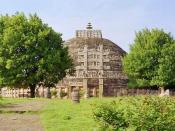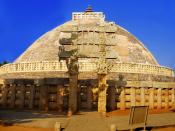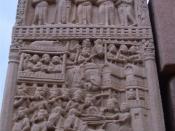The basic geometrical designs of certain shapes have caused them to be used symbolically in different religions to signify various meanings without text. For example the cross symbolizes Christianity, the crucifixion of Christ and the incarnation of divinity and the square is often used to signify the four cardinal points of a compass as used in the great pyramids of Egypt. Another great example of this concept would be the circle. Since the circle has no start or end, it is used throughout art to represent the idea of the continuation of life, the purity of the holy, the universe and the divine. In Buddhism, circular designs are often used to represent different aspects of there religion. Example of that would be with the wheel which stands for the endless cycle of birth and rebirth or the circle of life (night and day and so on) and with the rounded dome Stupas which symbolizes earth.
When looking at The Great Stupa at Sanchi the concept of the circle and its connections with the divine and sacred can be clearly seen in the design and function.
The Great Stupa at Sanchi was built by the Mauryan emperor Ashoka during the 1st century. The Great Stupa, along with all other Stupas, came from the ritual usually used for the burial mounds once used for the burial of royalty in India and was adopted by Buddhists as one of their main symbols and as the center of their religious compounds. Supposedly, Buddha upon his death requested to be buried in this manor to bridge the gap between himself and the upper class to show that he was no different then them. The remains and relics of Buddha are placed within the stupa which also acts as a symbol to commemorate a sacred...


